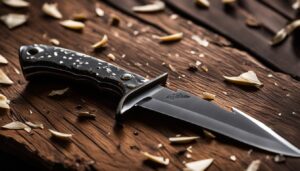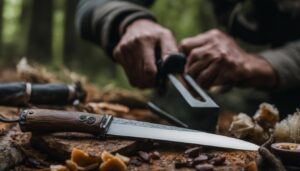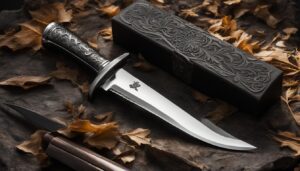Keeping your knives sharp is not only about efficiency but also about safety. A sharper blade reduces the risk of accidents. Understanding the science behind sharpness and choosing the right sharpening method are key. Different sharpening techniques, such as using whetstones or electric sharpeners, offer unique benefits. Traditional hand honing using quality stones provides unmatched sharpness, while electric or manual sharpeners are great for quick touch-ups. Safety precautions should always be taken during knife sharpening.
Key Takeaways:
- Hunting knife edge maintenance is crucial for safety and efficiency.
- Understanding the science behind sharpness helps in making informed choices.
- Different sharpening techniques offer unique benefits for specific needs.
- Safety precautions should be observed during knife sharpening.
- Choosing the right sharpening method depends on personal preference and the task at hand.
The Science of Knife Sharpening
Knife sharpening is a fascinating blend of art and science. A sharp blade not only enhances efficiency but also plays a crucial role in ensuring safety during cutting tasks. The science behind knife sharpening lies in understanding the microscopic structure of the blade and how it affects the sharpness.
When a knife is dull, tiny jagged teeth called burrs are formed along the edge. These burrs can snag on materials, reducing the cutting efficiency. Scientific studies have shown that sharper blades require less force to cut through objects, making them more effective and efficient for various cutting tasks.
By understanding the physics behind sharpness, we can make informed choices when it comes to knife sharpening techniques and tools. Whether it’s using traditional whetstones, electric sharpeners, or other methods, the goal is to achieve optimal sharpness and minimize the resistance encountered during cutting tasks.
The Microscopic Structure of a Sharp Blade
| Microscopic Structure | Effect on Sharpness |
|---|---|
| Uniform and aligned edge particles | Creates a smooth cutting surface |
| Minimal burrs or jagged teeth | Reduces resistance and enhances cutting efficiency |
| Sharp angle at the edge | Allows for precise cutting |
“A sharper blade requires less force to cut through materials, making it more efficient and safer to use.”
Reducing Resistance for Enhanced Sharpness
To achieve optimal sharpness, it’s important to reduce resistance during cutting tasks. This can be accomplished by properly sharpening the blade and maintaining its edge. While different sharpening methods and tools offer their unique benefits, the key is to ensure the microscopic structure of the blade is aligned, with minimal burrs or jagged teeth.
By understanding the science of knife sharpening and the impact of microscopic structure on sharpness, we can make informed choices when it comes to maintaining and sharpening our knives. Whether you’re a hunting enthusiast or a professional chef, knowing the science behind knife sharpening empowers you to optimize your blade’s performance and ensure a safer cutting experience.
Knife Sharpeners Explained
When it comes to knife sharpening, there are various options available to choose from. Two popular choices are manual sharpening methods and electric sharpeners. Each option offers its own advantages and considerations that should be taken into account based on personal preference and specific needs. Let’s explore the key features of each.
Manual Sharpening
Manual sharpening methods, such as using whetstones or honing rods, provide users with more control and precision. These methods require skill and practice to achieve optimal results. Whetstones, also known as sharpening stones, come in different materials and grit sizes, allowing for a range of sharpening options. The material type and grit size determine the level of abrasion and polishing during the sharpening process, ultimately affecting the sharpness of the blade.
Electric Sharpeners
On the other hand, electric sharpeners offer convenience and efficiency. They are particularly useful for quick touch-ups and can save time compared to manual sharpening methods. Electric sharpeners typically have rotating sharpening wheels or belts that quickly and easily sharpen the blade. However, it is important to note that electric sharpeners require a power source to function and may have limitations on the type and size of blades they can sharpen.
Choosing the Right Option
When deciding between manual sharpening and electric sharpeners, consider factors such as the level of control desired, the type of blades being sharpened, and the convenience of the sharpening process. Manual sharpening methods are often preferred by those who value precision and enjoy the hands-on experience of sharpening their knives. Electric sharpeners, on the other hand, are favored by individuals who prioritize convenience and efficiency. Ultimately, the choice between manual and electric sharpeners depends on individual preferences and requirements.
| Manual Sharpening | Electric Sharpeners | |
|---|---|---|
| Control | High | Medium |
| Convenience | Low | High |
| Efficiency | Medium | High |
| Compatibility | Wide range of blades | May have limitations |
| Skill Level Required | High | Low |
Understanding the differences and benefits of manual sharpening versus electric sharpeners can help you make an informed decision when it comes to maintaining the sharpness of your knives. Whether you prefer the precision of manual sharpening or the convenience of electric sharpeners, proper knife maintenance will ensure optimal performance and safety in your hunting pursuits.

Proficiency in Using Whetstones
When it comes to knife sharpening, whetstones are a popular choice among seasoned blade enthusiasts. Mastering the use of whetstones requires attention to detail and practice, but the results are well worth the effort. Whetstone sharpening allows for precise control over the sharpening process, resulting in a razor-sharp edge that can tackle any cutting task with ease.
One important aspect of using whetstones is understanding the correct angle at which to sharpen the knife. The angle plays a crucial role in achieving the desired sharpness. Generally, the sharpening angle for most knives falls between 15 to 20 degrees, but it can vary depending on the knife’s purpose and design. Using angle guides can help maintain consistency and ensure that the correct angle is maintained throughout the sharpening process.
Another key consideration when using whetstones is selecting the right grit size. Whetstones come in various grits, ranging from coarse to fine. Coarse grits, typically around 400 to 600, are used to reshape damaged or dull blades. As the sharpening process progresses, finer grits, such as 1000 to 3000, are employed to refine the edge and achieve a smooth finish. For a truly polished edge, extra fine grits, ranging from 4000 to 8000, can be used to give the blade a mirror-like shine.
| Whetstone Grit | Recommended Use |
|---|---|
| 400-600 | Reshaping damaged or dull blades |
| 1000-3000 | Refining the edge and achieving a smooth finish |
| 4000-8000 | Polishing the blade for a mirror-like shine |
In conclusion, proficiency in using whetstones for knife sharpening involves mastering the correct angle and selecting the appropriate grit size. Practice, patience, and attention to detail are essential for achieving a razor-sharp edge that will enhance the performance of your hunting knife. With the right technique and the proper use of whetstones, you can ensure that your blade remains in optimal condition for a lifetime of hunting adventures.


The Debate Between Electric vs Manual Sharpeners
When it comes to sharpening your hunting knife, the choice between electric sharpeners and manual methods like whetstones is an important decision to make. Both options offer unique benefits, so let’s weigh the factors and find the right fit for you.
Convenience and Control
If convenience is your priority, electric sharpeners are the way to go. With their fast and automated sharpening process, they are perfect for quick touch-ups. On the other hand, if you value control and versatility, manual sharpening methods like whetstones allow you to fine-tune your knife’s edge to perfection. It’s all about finding the right balance between ease of use and precision.
Durability and Maintenance
When it comes to durability, manual sharpening tools tend to have the upper hand. With proper care and maintenance, they can last a lifetime. Electric sharpeners, on the other hand, may require regular maintenance and can be prone to wear and tear over time. So, if you’re looking for a long-term investment, manual sharpening tools are the way to go.
Final Verdict
Ultimately, the choice between electric sharpeners and manual methods boils down to your personal preference and specific needs. If you prioritize convenience and efficiency, electric sharpeners are a great choice. But if you value control, precision, and long-term durability, manual sharpening methods like whetstones are hard to beat. So, I encourage you to consider your priorities and make an informed decision that suits your hunting knife sharpening needs.
FAQ
Why is keeping knives sharp important?
Keeping knives sharp is important for both efficiency and safety. A sharper blade reduces the risk of accidents and enhances cutting efficiency.
What are burrs, and why are they a problem?
Burrs are jagged teeth that form on a dull blade and can snag on materials, reducing cutting efficiency. They can also lead to uneven cuts.
How does a sharper blade require less force for cutting?
Scientific studies have shown that sharper blades require less force for cutting tasks. This reduces fatigue and provides a more efficient cutting experience.
What types of knife sharpeners are available?
There are both manual and electric sharpening options available. Manual methods include whetstones and honing rods, while electric sharpeners offer convenience and efficiency.
What should I consider when choosing a sharpener?
Factors such as material type and grit size should be considered when choosing a sharpener. Different materials and grit sizes offer varying levels of abrasion and polishing.
How do I achieve a razor-sharp edge using a whetstone?
Mastering the correct angle and using proper angle guides can help achieve consistent results. Selecting the right abrasive grits, typically between 4000 to 8000 grit, is also essential for a finely honed edge.
What are the advantages of electric sharpeners over manual methods?
Electric sharpeners offer convenience and are great for quick touch-ups. They require a power source but provide efficient results. Manual methods, on the other hand, offer more control and versatility.
Which type of sharpener is more durable?
Manual sharpening tools tend to last longer with proper care and maintenance. Electric sharpeners may require more frequent replacement or repairs.
How do I choose between electric and manual sharpeners?
The choice between electric and manual sharpeners depends on personal preference and specific needs. Consider factors like convenience, control, and the type of sharpening required.





